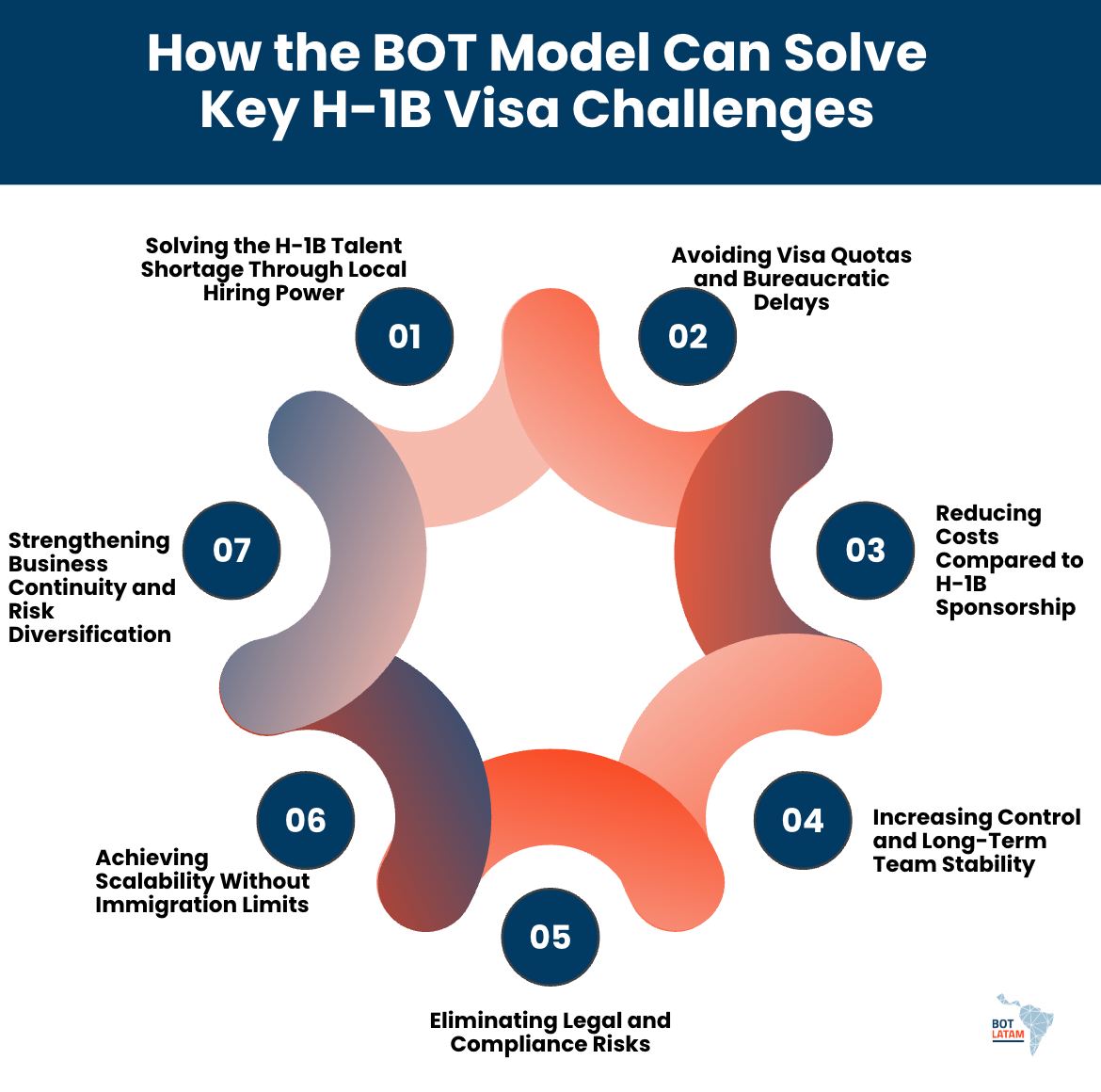The U.S. tech sector is facing a reality check. With H-1B visa approval rates falling below 70% in recent years, according to USCIS, and rising competition for skilled developers, many companies are rethinking how they build global teams. The question isn’t just about finding talent anymore but about where and how to do so sustainably.
That’s where the Build-Operate-Transfer (BOT) model comes in. Instead of relying on costly visa programs, more U.S. firms are establishing nearshore tech teams in Latin America, where time zones align, costs are lower, and legal frameworks favor long-term operations.
In this article, you’ll explore how the BOT model is emerging as a practical H-1B visa alternative, why Latin America is becoming a key hub for nearshore innovation, and what this strategic shift means for your company’s future workforce strategy. You’ll also see how the BOT model helps U.S. companies scale faster, maintain control, and reduce dependency on unpredictable immigration policies, all while building stronger, more agile teams close to home. Ready to get started? Keep reading!
Understanding the H-1B Visa and Its Growing Limitations
The H-1B visa has long served as a bridge between U.S. companies and global tech talent. But as competition intensifies and regulations tighten, its weaknesses are becoming more apparent. Below are the key limitations every business leader should understand before relying on this program as a long-term talent strategy.
Limited Availability and Lottery-Based Selection.
Each fiscal year, the U.S. Citizenship and Immigration Services (USCIS) issues a cap of 85,000 H-1B visas, including 20,000 for advanced degree holders. In 2024, over 700,000 applications were submitted, with an acceptance rate of less than 12%, according to USCIS. This lottery-based selection system makes hiring unpredictable. Even qualified candidates are left out simply because demand far exceeds supply. For growing tech companies, that uncertainty can derail product timelines and expansion plans.
Unpredictable Approval Process.
Meeting every eligibility requirement doesn’t guarantee approval. The H-1B process is known for its administrative complexity and high rejection rates. Small documentation errors or changes in immigration policy can delay or deny applications. This unpredictability forces companies to build contingency plans, often increasing costs and stretching internal HR and legal resources.
Rising Costs and Legal Fees.
Hiring foreign talent through the H-1B program isn’t cheap. Between filing fees, legal counsel, and premium processing, costs can range from $1,500 to more than $7,000 per visa, and that’s before factoring in renewals every three years. For smaller organizations or startups competing with enterprise budgets, these expenses can quickly erode the financial advantage of global hiring.
Lengthy Processing Times.
Even with premium processing, which costs an additional $2,805, according to data from USCIS,, securing an H-1B visa can take months. Standard applications often take three to six months, not including preparation time. These delays can halt hiring momentum, leaving critical roles unfilled and slowing down project execution.
Compliance Burdens and Legal Risk.
Employers sponsoring H-1B workers must comply with strict Department of Labor regulations, including prevailing wage requirements and detailed documentation of job duties. Any discrepancies can trigger audits or fines. The administrative workload and legal exposure make the program risky, especially for companies without in-house immigration expertise.
Limited Scalability for Fast-Growing Teams.
The H-1B system was designed for individual sponsorship, not for scaling teams rapidly. Each new hire requires a separate petition, approval, and legal review. As a result, building large, distributed engineering teams under this model becomes slow and inefficient. For companies needing to expand quickly in a competitive market, this structure simply doesn’t keep pace.
Dependence on Policy Changes.
U.S. immigration policies are subject to frequent revisions, often driven by shifting political priorities. A change in administration can alter quotas, wage thresholds, or eligibility requirements overnight. This volatility leaves companies exposed, forcing them to constantly adapt their hiring strategies around uncertain legislation.
How the BOT Model Can Solve Key H-1B Visa Challenges

The Build-Operate-Transfer (BOT) model offers a structured, low-risk alternative to the unpredictable nature of the H-1B visa system. Instead of sponsoring individual employees abroad, you can build and manage entire tech teams in nearshore locations, gaining access to talent without navigating complex U.S. immigration rules. Below are the core ways the BOT model addresses specific H-1B challenges.
Solving the H-1B Talent Shortage Through Local Hiring Power:
Rather than competing in the H-1B lottery, the BOT model lets you tap directly into Latin America’s growing tech talent pool, where countries like Mexico, Colombia, and Brazil collectively produce over 500,000 STEM graduates each year, according to UNESCO. You gain access to skilled software engineers, data analysts, and DevOps experts who are available year-round, not subject to visa caps or random selection. This structure eliminates the uncertainty that limits traditional immigration-based hiring.
Avoiding Visa Quotas and Bureaucratic Delays:
The BOT model removes dependence on annual visa cycles and government approval processes. Your company can establish operations within weeks, not months, by partnering with a local entity that handles recruitment, payroll, and compliance during the “Operate” phase. This speed allows you to scale teams in real time to meet project deadlines and market shifts, avoiding the multi-month delays that accompany U.S. visa filings.
Reducing Costs Compared to H-1B Sponsorship:
An H-1B hire can cost between $10,000 and $25,000 when you include filing fees, attorney costs, relocation, and overhead, according to NFAP. In contrast, nearshore BOT operations can reduce total hiring and operational costs by 30% to 50%, depending on the country and role type, according to NASSCOM. You gain financial flexibility to reinvest in innovation, product development, or local upskilling programs instead of visa expenses.
Increasing Control and Long-Term Team Stability:
Unlike traditional outsourcing, a BOT operation transitions full ownership of your team and infrastructure once it’s mature. This means you retain IP rights, cultural alignment, and process control, something H-1B arrangements can’t guarantee when employees remain physically in the U.S. but legally tied to temporary work visas. The transfer stage allows you to internalize the team as a seamless extension of your company, ensuring continuity without the risk of turnover linked to visa expirations or renewals.
Eliminating Legal and Compliance Risks:
H-1B sponsorship exposes companies to compliance audits, Department of Labor wage requirements, and changing immigration regulations. With the BOT model, those risks shift to the local operating entity during the “Build” and “Operate” phases. They handle labor laws, payroll taxes, and HR compliance according to local regulations. Once the transfer occurs, your business inherits a compliant and fully functional entity, without ever engaging in direct visa management.
Achieving Scalability Without Immigration Limits:
Every H-1B employee requires a separate petition, but the BOT structure allows scaling entire teams simultaneously. Whether you need ten or a hundred developers, you can expand quickly within the same operational framework. The model’s flexibility supports agile growth across product lines or business units, without waiting for the next H-1B filing window or facing quota restrictions.
Strengthening Business Continuity and Risk Diversification:
Visa-dependent hiring centralizes risk in one location. If visa policies change or employees face renewal issues, your operations suffer. By using the BOT model to establish a nearshore tech hub, you distribute that risk geographically. This diversification ensures business continuity, even when immigration or political conditions fluctuate in the U.S.
Latin America’s Role in the New U.S. Talent Strategy
1. Strategic Nearshore Location for U.S. Companies
Proximity is one of Latin America’s biggest advantages. The region operates within one to three time zones of the U.S., making real-time collaboration easy and efficient. Unlike offshore destinations in Asia, teams in Mexico, Colombia, or Costa Rica can join daily standups or client calls without schedule friction. This alignment improves delivery speed and productivity, which are critical in agile software development environments.
2. A Rapidly Expanding Tech Workforce
Latin America has built a strong foundation of STEM-focused education and technical training. According to UNESCO, over 500,000 engineers and IT graduates enter the workforce annually across the region. Brazil, Mexico, and Colombia lead the list, while emerging hubs like Chile and Uruguay are quickly gaining ground. This consistent talent pipeline gives U.S. firms reliable access to skilled developers, QA testers, and data engineers without relying on visa programs.
3. Competitive Labor Costs With High Skill Levels
The region combines affordability with technical excellence. Research by Accelerance shows that average software development rates in Latin America are 40% to 60% lower than in the U.S., while maintaining strong English proficiency and modern tech stack expertise. Developers in major hubs like Guadalajara, Medellín, and Buenos Aires are fluent in cloud technologies, AI frameworks, and cybersecurity, skills that directly align with current U.S. market needs.
4. Cultural and Business Compatibility
Shared work culture is another factor driving U.S. investment in the region. Latin American professionals typically adapt quickly to North American business norms, communication styles, and management structures. The cultural alignment rate between U.S. and LATAM teams is over 80%, according to Deloitte’s 2023 Nearshore Report, contributing to smoother onboarding, stronger collaboration, and lower attrition.
5. Stable Digital Infrastructure and Government Support
Many Latin American governments have actively promoted tech investment and nearshore development through tax incentives, digital infrastructure upgrades, and startup programs. For example, Chile’s Startup Chile initiative and Colombia’s “Vive Digital” program have positioned both nations as nearshore innovation centers. Fiber connectivity and tech parks across Argentina further enhance operational reliability for remote and hybrid teams.
6. Reducing Dependency on the H-1B Pipeline
By developing nearshore operations in Latin America, U.S. companies reduce reliance on unpredictable visa systems. Instead of waiting months for approvals, you can establish engineering or R&D teams regionally, ensuring continuity regardless of immigration policies. This approach diversifies your workforce geographically and strategically, maintaining U.S. oversight while leveraging global expertise.
7. A Long-Term Solution for Sustainable Growth
Latin America offers more than short-term relief, it provides a long-term, strategic alternative to traditional talent acquisition. As U.S. companies prioritize flexibility and speed in global hiring, the region’s blend of cost efficiency, skilled talent, and close proximity positions it as the foundation of the next generation of nearshore tech ecosystems.
The Future of U.S. Tech Talent Strategy: From H-1B Reliance to Nearshore Expansion
A Shift Driven by Structural Workforce Challenges:
According to CompTIA’s 2024 Tech Jobs Report, the U.S. faces a shortage of more than 300,000 skilled tech professionals, with demand growing faster than domestic supply. The H-1B program, capped at 85,000 new visas per year, cannot meet that need. This structural gap has accelerated the search for scalable alternatives, leading enterprises to establish nearshore engineering hubs instead of relying on limited visa pipelines.
Nearshore Expansion as a Core Strategic Move:
Rather than outsourcing short-term projects, companies are building permanent tech operations in nearshore markets. These teams work as integrated extensions of U.S. departments, ensuring alignment across product development, cybersecurity, and data management. Nearshoring allows you to maintain control over IP, standards, and communication, something far more difficult to achieve through H-1B or offshore-only strategies.
Resilience Against Policy and Economic Volatility:
Immigration policy shifts can disrupt business continuity. During recent years, H-1B processing times have fluctuated, and approval criteria have tightened, causing uncertainty for employers and employees alike. By contrast, nearshore models in Latin America provide operational resilience, with teams functioning under stable regional frameworks. If U.S. visa rules change, your workforce remains unaffected and productive, ensuring continuity across product cycles and client commitments.
Technology, Remote Work, and the End of Geographic Barriers:
The rise of remote-first and hybrid work environments has eliminated the necessity of relocating foreign talent to U.S. soil. Gartner reports that 58% of tech companies now employ fully distributed teams, according to Gartner. With cloud infrastructure and collaboration tools maturing, teams in Mexico City, Bogotá, or Buenos Aires can contribute as seamlessly as teams in Austin or Seattle. This shift transforms location from a barrier into a competitive advantage.
Competitive Advantage Through Cost and Time Optimization:
Beyond talent access, nearshore expansion offers measurable financial and operational benefits. Latin America’s developer rates are 40% to 60% lower than U.S. averages, according to Accelerance, and shared time zones minimize productivity loss from asynchronous workflows. Projects move faster, communication improves, and resource allocation becomes more predictable, advantages that directly impact bottom-line performance.
Government Incentives and Ecosystem Maturity:
Countries like Colombia, and Chile have strengthened their positions by introducing tech-focused tax incentives, innovation zones, and startup acceleration programs. For U.S. companies, these maturing ecosystems make nearshore expansion a sustainable long-term play, not a temporary cost-cutting measure.
A Future Defined by Proximity, Partnership, and Permanence:
The next era of U.S. talent strategy will center on proximity-based collaboration rather than visa-dependent hiring. Instead of relocating global professionals to the U.S., companies will increasingly build high-performance teams where the talent already is, in Latin America. The result is a more stable, cost-efficient, and innovative workforce model designed to keep pace with rapid technological change.
Ready to Hire Tech Talent with BOT LATAM?
The shift from H-1B dependency to nearshore expansion isn’t just a hiring adjustment, it’s a strategic transformation. As U.S. companies confront tighter immigration quotas and an ongoing tech talent shortage, nearshore BOT operations in Latin America are becoming a proven alternative for sustainable, scalable growth. According to the Inter-American Development Bank, Latin America’s digital economy is expanding at over 7% annually, making it one of the fastest-growing global hubs for technology services and innovation.
At BOT LATAM, we’ve helped U.S. organizations establish fully operational nearshore centers that combine local expertise with long-term ownership. From regulatory setup to talent acquisition and operational transfer, our model ensures compliance, scalability, and performance from day one. We bring regional experience, proven frameworks, and a transparent process that allows companies to grow without the risks and delays of visa-dependent hiring.
As global talent strategies evolve, Latin America offers a unique blend of proximity, skill, and reliability. We will help you turn that opportunity into a competitive advantage, building teams that deliver, innovate, and stay aligned with your business goals. Schedule a call today!

Revolutionize Your Workflow with Our Innovative BOT Strategy!
Enhance your operations seamlessly and adapt to market demands
Contact Us

.jpg)


%2017.26.38.png)